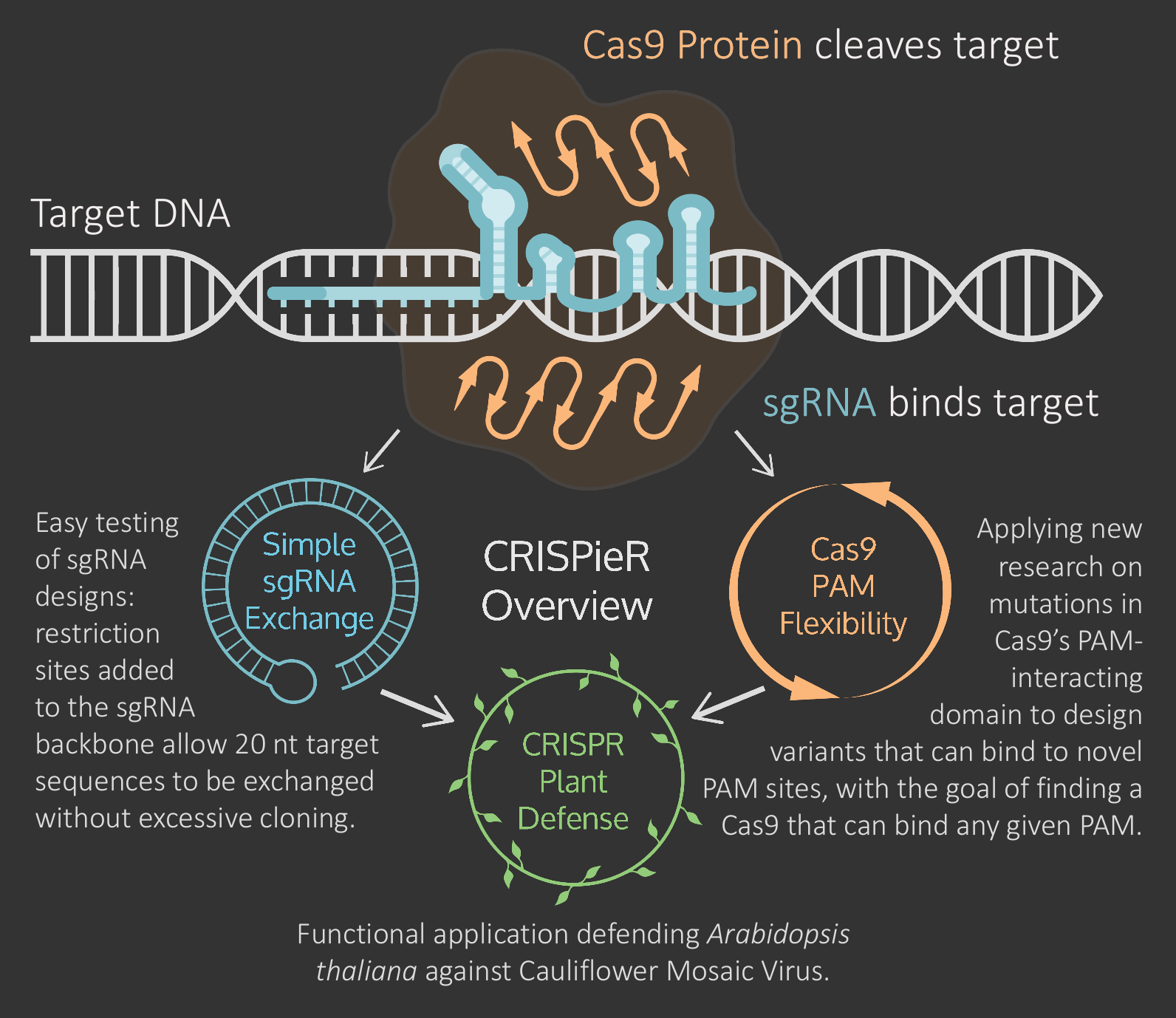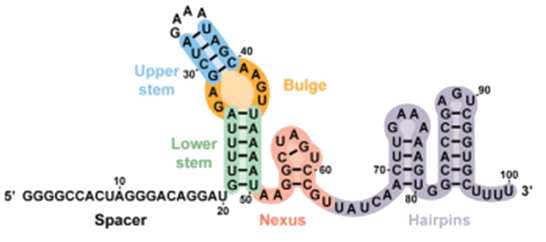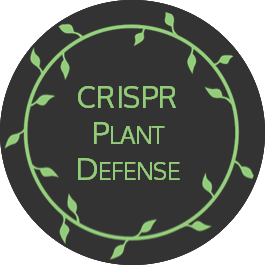Difference between revisions of "Team:Waterloo/Description"
m |
(adds lots of new graphics) |
||
| (One intermediate revision by one other user not shown) | |||
| Line 8: | Line 8: | ||
<h2>Motivation</h2> | <h2>Motivation</h2> | ||
<p> | <p> | ||
| − | The clustered regularly interspaced short palindromic repeats (CRISPR)-Cas9 system is an | + | The clustered regularly interspaced short palindromic repeats (CRISPR)-Cas9 system is an exciting tool for synthetic biologists because it can target and edit genomes with unprecedented specificity. The <span class="orangetext">Cas9 Protein</span> binds to a PAM site (NGG), attempts to match its <span class="bluetext">sgRNA target sequence</span> to the adjacent DNA strand and cleaves the DNA if it finds a match. Since its popularization, CRISPR papers have flooded major journals and many iGEM teams have worked to improve its use as a genome editing tool.</p> |
| + | <p>The 2015 Waterloo team is taking a three-pronged approach to expand upon previous research for wider, more efficient, and more flexible use of CRISPR-Cas9: easy testing of sgRNA designs with our <span class="bluetext">Simple sgRNA Exchange</span> design, applying research on new mutations in Cas9's PAM-interacting domain to enable <span class="orangetext">Cas9 PAM Flexibility</span> and applying our work as a <span class="greentext">CRISPR Plant Defense</span> protecting <em>A. thaliana</em> against infection by Cauliflower Mosaic Virus. | ||
</p> | </p> | ||
<figure> | <figure> | ||
| − | <img src="/wiki/images/ | + | <img src="/wiki/images/1/1a/Waterloo_project-overview.png" alt="CRISPR-Cas9 structure and project overview" /> |
| − | <figcaption>CRISPR-Cas9 | + | <figcaption>Overview of CRISPR-Cas9 structure and project sections</figcaption> |
| − | + | ||
| − | + | ||
| − | + | ||
| − | + | ||
| − | + | ||
| − | + | ||
</figure> | </figure> | ||
</section> | </section> | ||
| Line 24: | Line 19: | ||
<section id="sgRNA" title="sgRNA Modification" class="sgRNAmod"> | <section id="sgRNA" title="sgRNA Modification" class="sgRNAmod"> | ||
<h2>Simple sgRNA Exchange</h2> | <h2>Simple sgRNA Exchange</h2> | ||
| + | <figure style="float:left; max-width:30%; width:150px;"> | ||
| + | <img src="/wiki/images/8/85/Waterloo_sgrnaexchangeicon.png" alt="sgRNA Exchange Icon" /> | ||
| + | </figure> | ||
<p> | <p> | ||
| − | We aim to make target selection and guide sequence replacement physically easier in the lab. To target a DNA sequence, a single guide RNA (sgRNA) is used to identify a match <cite ref="Horvath2010"></cite>. | + | We aim to make target selection and guide sequence replacement physically easier in the lab. To target a DNA sequence, a single guide RNA (sgRNA) is used to identify a match <cite ref="Horvath2010"></cite>. We modify the sgRNA secondary structure analyzed by Briner et al. <cite ref="Briner2014"></cite> to contain a restriction site. This makes it possible to swap out a 20 base pair section of the sgRNA sequences, instead of synthesizing new targets from scratch, so there is no need to re-synthesize and re-clone the entire sgRNA sequence for each new target we'd like to test. We hope our design reduces the turnaround time for using CRISPR to target different sequences. |
</p> | </p> | ||
<figure> | <figure> | ||
| Line 39: | Line 37: | ||
</figure> | </figure> | ||
<p class="desc-links" style="text-align:center;"> | <p class="desc-links" style="text-align:center;"> | ||
| − | <a href=" | + | <a href="/Team:Waterloo/Lab/sgRNA">Background and Results</a> |
| − | + | ||
</p> | </p> | ||
</section> | </section> | ||
| Line 46: | Line 43: | ||
<section id="cas9" title="Cas9 PAM Flexibility" class="cas9mod"> | <section id="cas9" title="Cas9 PAM Flexibility" class="cas9mod"> | ||
<h2>Cas9 PAM Flexibility</h2> | <h2>Cas9 PAM Flexibility</h2> | ||
| − | <figure style="float:left; width: | + | <figure style="float:left; max-width:30%; width:150px;"> |
| − | <img src="/wiki/images/ | + | <img src="/wiki/images/7/72/Waterloo_pamflexeicon.png" alt="Pam Exchange Icon" /> |
| − | + | ||
</figure> | </figure> | ||
<p> | <p> | ||
| Line 54: | Line 50: | ||
</p> | </p> | ||
<p class="desc-links" style="text-align:center;"> | <p class="desc-links" style="text-align:center;"> | ||
| − | <a href=" | + | <a href="/Team:Waterloo/Lab/dCas9">Lab Design</a> |
| − | + | <a href="/Team:Waterloo/Modeling/PAM_Flexibility">Modeling</a> | |
| − | <a href=" | + | <a href="/Team:Waterloo/Practices/Human_Practices">IP Laws</a> |
| − | <a href=" | + | |
</p> | </p> | ||
</section> | </section> | ||
| Line 63: | Line 58: | ||
<section id="plants" title="CRISPR Plant Defense" class="plantmod"> | <section id="plants" title="CRISPR Plant Defense" class="plantmod"> | ||
<h2>CRISPR Plant Defense</h2> | <h2>CRISPR Plant Defense</h2> | ||
| − | <figure style="float: | + | <figure style="float:left; max-width:30%; width:150px;"> |
| − | <img src="/wiki/images/ | + | <img src="/wiki/images/7/73/Waterloo_plantdefenseicon.png" alt="Plant Defense Icon" /> |
| − | + | ||
| − | + | ||
| − | + | ||
| − | + | ||
| − | + | ||
| − | + | ||
| − | + | ||
| − | + | ||
</figure> | </figure> | ||
| − | <p | + | <p> |
Finally, CRISPR originated as a viral defence mechanism for bacteria, for specific and targeted immunity <cite ref="Horvath2010"></cite>. Multi-cellular organisms have developed their own defenses to achieve this goal, but from our research it appears that groups have not publicly attempted to introduce CRISPR as an antiviral mechanism in multicellular organisms. Our team is attempting to use the CRISPR system in plants to discover whether it can defend against a class of double-stranded DNA viruses. | Finally, CRISPR originated as a viral defence mechanism for bacteria, for specific and targeted immunity <cite ref="Horvath2010"></cite>. Multi-cellular organisms have developed their own defenses to achieve this goal, but from our research it appears that groups have not publicly attempted to introduce CRISPR as an antiviral mechanism in multicellular organisms. Our team is attempting to use the CRISPR system in plants to discover whether it can defend against a class of double-stranded DNA viruses. | ||
</p> | </p> | ||
<br> | <br> | ||
<p class="desc-links" style="text-align:center;"> | <p class="desc-links" style="text-align:center;"> | ||
| − | <a href=" | + | <a href="/Team:Waterloo/Modeling/CaMV_Biology">CaMV Background</a> |
| − | <a href=" | + | <a href="/Team:Waterloo/Lab/Plants">Lab Design</a> |
| − | <a href=" | + | <a href="/Team:Waterloo/Modeling/CaMV_Replication">Modeling CaMV Replication</a> |
| − | <a href=" | + | <a href="/Team:Waterloo/Modeling/Intercellular_Spread">Modeling Intercellular Spread</a> |
| + | <a href="/Team:Waterloo/Practices/Commercialization">Commercialization</a> | ||
</p> | </p> | ||
</section> | </section> | ||
Latest revision as of 17:01, 20 November 2015
Project Description
Motivation
The clustered regularly interspaced short palindromic repeats (CRISPR)-Cas9 system is an exciting tool for synthetic biologists because it can target and edit genomes with unprecedented specificity. The Cas9 Protein binds to a PAM site (NGG), attempts to match its sgRNA target sequence to the adjacent DNA strand and cleaves the DNA if it finds a match. Since its popularization, CRISPR papers have flooded major journals and many iGEM teams have worked to improve its use as a genome editing tool.
The 2015 Waterloo team is taking a three-pronged approach to expand upon previous research for wider, more efficient, and more flexible use of CRISPR-Cas9: easy testing of sgRNA designs with our Simple sgRNA Exchange design, applying research on new mutations in Cas9's PAM-interacting domain to enable Cas9 PAM Flexibility and applying our work as a CRISPR Plant Defense protecting A. thaliana against infection by Cauliflower Mosaic Virus.

Simple sgRNA Exchange

We aim to make target selection and guide sequence replacement physically easier in the lab. To target a DNA sequence, a single guide RNA (sgRNA) is used to identify a match . We modify the sgRNA secondary structure analyzed by Briner et al. to contain a restriction site. This makes it possible to swap out a 20 base pair section of the sgRNA sequences, instead of synthesizing new targets from scratch, so there is no need to re-synthesize and re-clone the entire sgRNA sequence for each new target we'd like to test. We hope our design reduces the turnaround time for using CRISPR to target different sequences.

- Briner et al., 2014
- Cropped image
- Link to Original Photo
Cas9 PAM Flexibility

By building on recent papers, such as , we are trying to make Cas9’s binding to a protospacer adjacent motif (PAM) site more flexible. The standard S. pyogenes type II CRISPR-Cas9 binds to a PAM of length 3, namely NGG . While this is fairly general, requiring that this sequence be next to the target sequence limits where Cas9 can cut. We have produced a model that suggests Cas9 variants and their preferred PAM sites, and we attempted to demonstrate this model’s validity. The overarching goal is to create Cas9 variants that will bind to any desired PAM site, and we hope to take some significant steps forward to make that goal more achievable and directed.
CRISPR Plant Defense

Finally, CRISPR originated as a viral defence mechanism for bacteria, for specific and targeted immunity . Multi-cellular organisms have developed their own defenses to achieve this goal, but from our research it appears that groups have not publicly attempted to introduce CRISPR as an antiviral mechanism in multicellular organisms. Our team is attempting to use the CRISPR system in plants to discover whether it can defend against a class of double-stranded DNA viruses.
CaMV Background Lab Design Modeling CaMV Replication Modeling Intercellular Spread Commercialization